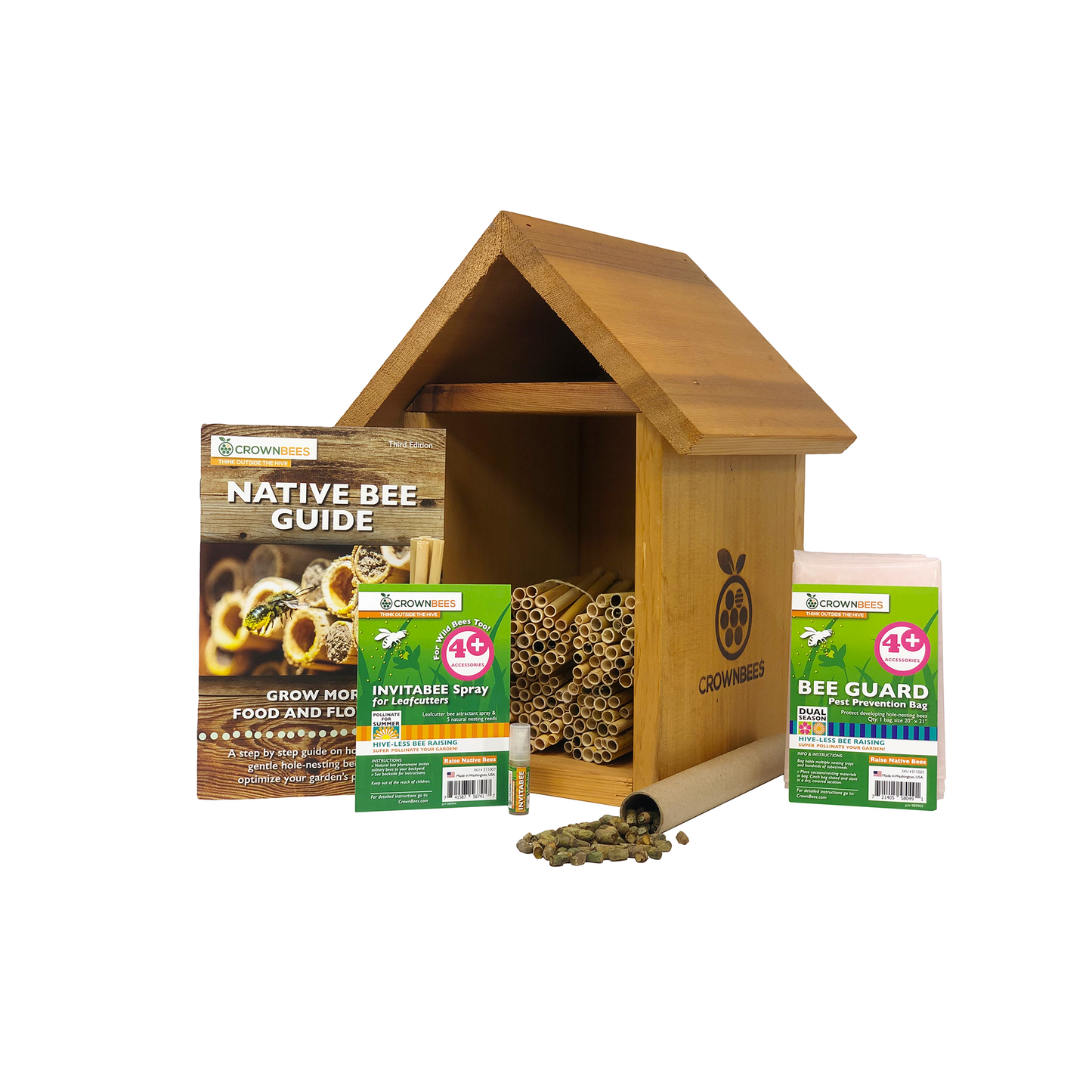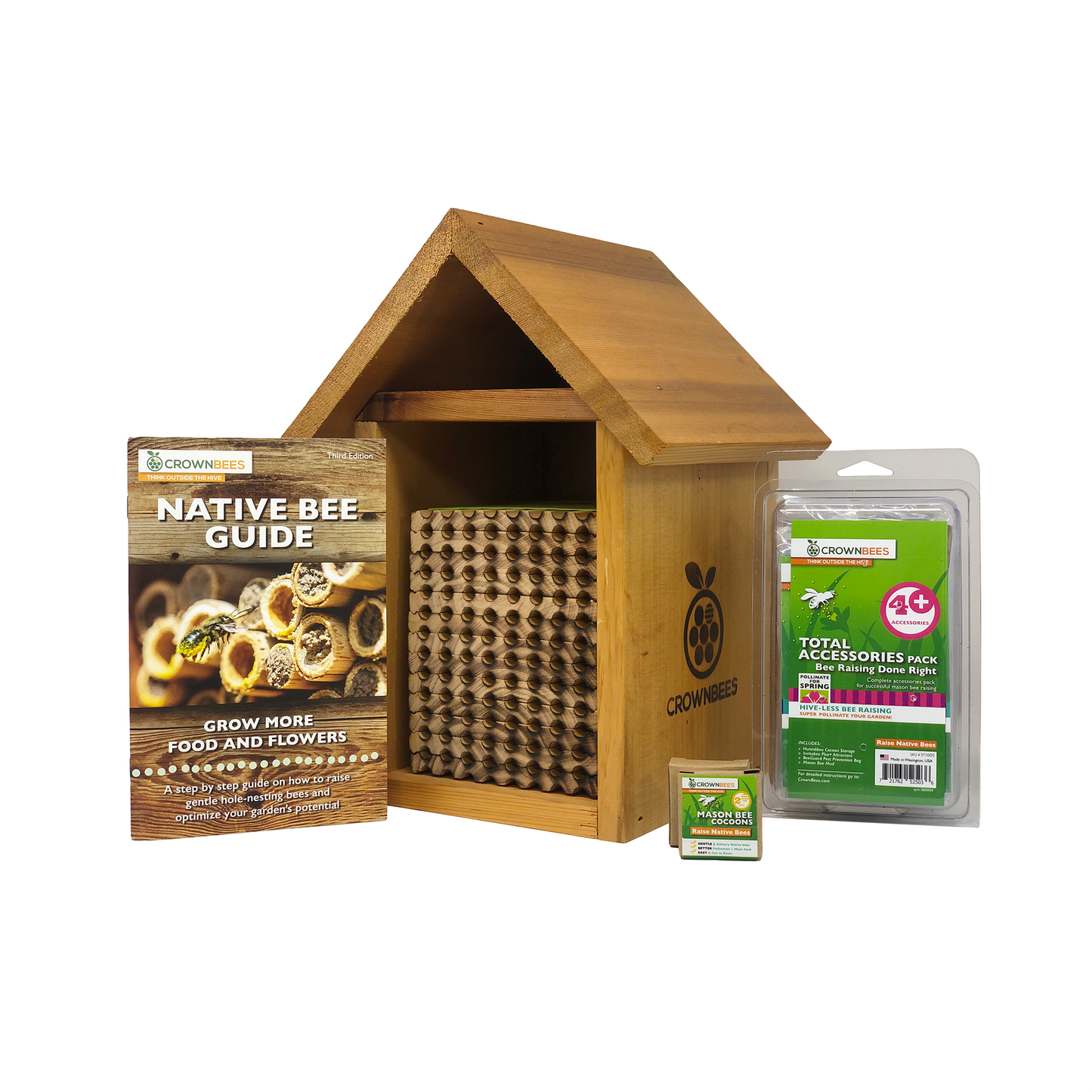
Hi! Whether you’re new to the world of mason bees, or a seasoned bee raiser looking for a refresher course, we’re here to help!
In this guide, we cover what to do once your mason bees arrive at your doorstep.
Step 1: Bee-cautious, Bees may have emerged during transit!
We are unable to regulate the temperature of your mason bee cocoons once they leave our facility. Sometimes extreme temperatures or shipping delays may cause your bees to emerge during transit. Please follow these simple instructions so you don't end up with mason bees flying all over your house!
To check to see if your bees have emerged, put the entire FedEx package in the fridge for 30 minutes before opening. The cold temps calms the bees and allows you to open the package without the risk of bees flying away. They may still try, but they should be slow enough to catch!
Step 2: Yard and Garden Prep Before Releasing Mason Bees
Please read our How to Release Mason Bee Cocoons for a more detailed description of yard and garden requirements for mason bee success. In short, your yard and garden is ready when:
- Your bee house is mounted on a solid object;
- Your bee house has 8mm nesting materials for female masons to build their nests;
- You have a cocoon hatchery to protect the cocoons from birds, sun, wind, and rain;
- You have a moist, clay-rich mud source within 25-50 ft. of your bee house;
- Daytime temperatures are at least 55°F/13°C or warmer;
- There are open blooms within 300 sq. ft. (100 sq.m) of your bee house; and,
- Your yard and garden is free of chemicals.
Step 3: Choose a Scenario
What you do next is based on your individual scenario.
Scenario 1: Emerged Bees + Yard and Garden Ready
If bees have emerged and your yard and garden is ready, then you can place any emerged bees and un-emerged cocoons inside your mason bee house. They'll get to work straight away!
Scenario 2: Emerged Bees + Yard and Garden NOT Ready
Since we ship our bees FedEx 2-Day (Canada Post in Canada) they sometimes arrive before your bee house. Or, maybe spring has come a little later than expected and your bees arrive before blooms are open and temperatures are warm enough. If this is the case you can put your bees into a state of forced hibernation by putting them back in the fridge until your yard and garden is ready. Don't be alarmed, the bees may appear dead in this dormant state, but they’ll be safe in your fridge until daytime temps reach 50-55°F and blooms are open.
To prevent bees from dehydrating while in the fridge, store the cocoons and emerged bees in a HumidiBee or other breathable container (that they cannot escape from) with a cotton ball soaked in a mixture of 1 tsp white sugar and 1 tsp water, change cotton ball when it is dry to the touch.
To avoid exposing bees/cocoons to light, loosely place a paper bag around the container. Place the container in the crisper drawer if space allows.
Emerged bees should be released as soon as possible!
Scenario 3: Unemerged Cocoons + Yard and Garden Ready
Excellent! You can place your cocoons in your cocoon hatchery or another small, breathable container to protect cocoons from birds, sun, wind, and rain until they are ready to emerge.
Bee Patient! Depending on the weather it can take up to three weeks for bees to emerge, but they are a lot of fun to watch once they do!
Scenario 4: Unemerged Cocoons + Yard and Garden NOT Ready
Keep cocoons in the fridge until your yard and garden is ready. To prevent bees from dehydrating while in the fridge, store the cocoons and emerged bees in a HumidiBee or other breathable container (that they cannot escape from) with a cotton ball soaked in a mixture of 1 tsp white sugar and 1 tsp water, change cotton ball when it is dry to the touch.
To avoid exposing cocoons to light, loosely place a paper bag around the container. Place the container in the crisper drawer if space allows.
Once your yard and garden is ready, you can place your cocoons in your cocoon hatchery or another small, breathable container to protect cocoons from birds, sun, wind, and rain until they are ready to emerge.
Bee Patient! Depending on the weather it can take up to three weeks for bees to emerge, but they are a lot of fun to watch once they do!
Pro Tip: You may wish to extend your bee season by releasing half your cocoons, then waiting a couple of weeks to release the second half. You can store mason bee cocoons in your refrigerator until you are ready to release the second half. The consistent cold temperatures of your fridge help the mason bees conserve their fat stores, so they emerge with sufficient energy to forage!
If you choose to split your cocoons, release various cocoon sizes to ensure you have both males and females in each batch -- encouraging mating! The larger cocoons are female bees, and smaller cocoons are male bees.
Just make sure you release all mason bee cocoons by mid-May!


